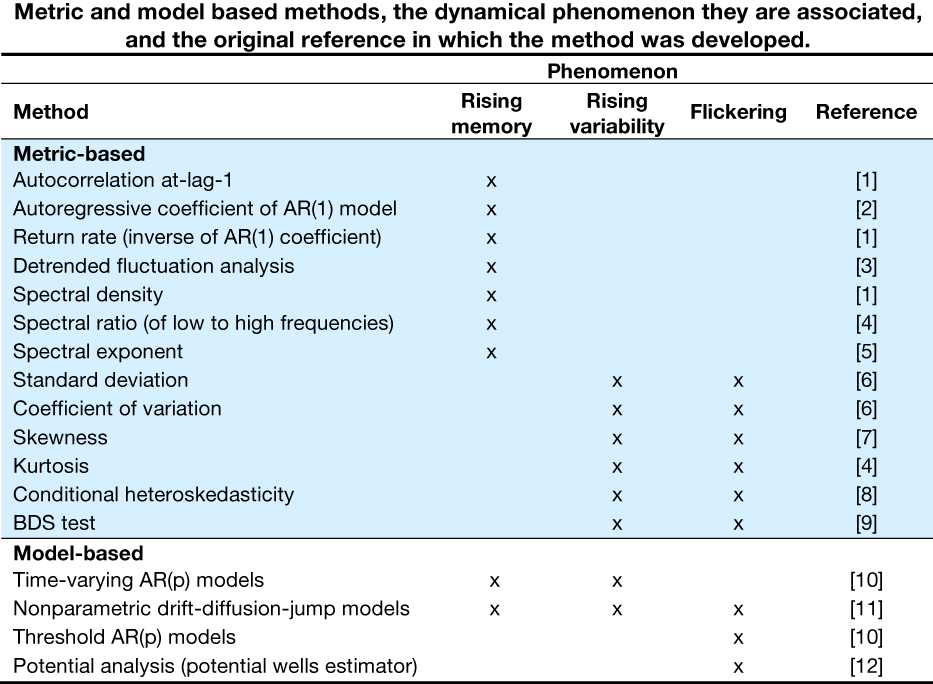Early-warning signals of critical transitions can be estimated using methods that can be classified into two broad categories: metric-based and model-based methods. Both types of methods quantify changes in the properties of the observed time series of a system that is generated by a general process:
dx = f(x,θ)dt + g(x,θ)dW
where x is the state of the system, f(x,θ) describes the deterministic part of the system, and g(x,θ)dW is the stochastic part; dW is a white-noise process. A slow change in the underlying conditions (drivers), θ,moves the system close to a threshold where a transition may occur.
Metric-based methods quantify changes in the statistical properties of the time series generated by equation 1 without attempting to fit the data with a specific model structure.
Model-based methods quantify changes in the time series by attempting to fit the data to a model that is based on the general structure of equation 1.
The ultimate goal of both types of methods is to capture changes in the ‘memory’ (correlation structure) and variability of a time series as it approaches a transition into an alternative dynamic regime.
1. Carpenter SR, Brock W a, Cole JJ, Kitchell JF, Pace ML, et al. (2008) Leading indicators of trophic cascades. Ecology letters 11: 128–138.
2. Held H, Kleinen T (2004) Detection of climate system bifurcations by degenerate fingerprinting. Geophysical Research Letters 31: 1–4. doi:10.1029/2004GL020972.
3. Livina VN, Lenton TM (2007) A modified method for detecting incipient bifurcations in a dynamical system. Geophysical Research Letters 34: 1–5.
4. Biggs R, Carpenter SR, Brock WA (2009) Turning back from the brink: Detecting an impending regime shift in time to avert it. Proceedings of the National Academy of Sciences 106: 826–831.
5. Dakos V, Carpenter SR, Brock WA, Ellison AM, Guttal V, et al. (2012) Methods for Detecting Early Warnings of Critical Transitions in Time Series Illustrated Using Simulated Ecological Data. PLoS ONE 7(7): e41010.
6. Carpenter SR, Brock WA (2006) Rising variance: a leading indicator of ecological transition. Ecology letters 9: 311–318.
7. Guttal V, Jayaprakash C (2008) Changing skewness: an early warning signal of regime shifts in ecosystems. Ecology Letters 11: 450–460.
8. Seekell DA, Carpenter SR, Pace ML (2011) Conditional heteroscedasticity as a leading indicator of ecological regime shifts. American Naturalist 178: 442–451.
9. Carpenter SR, Cole JJ, Pace ML, Batt R, Brock WA, et al. (2011) Early warnings of regime shifts: a whole-ecosystem experiment. Science 332: 1079–1082.
10. Ives AR, Dakos V (in press) Detecting dynamical changes in nonlinear time series using locally linear state-space models. Ecosphere.
11. Carpenter SR, Brock WA (2011) Early warnings of unknown nonlinear shifts: a nonparametric approach. Ecology 92: 2196–2201.
12. Livina VN, Kwasniok F, Lenton TM (2010) Potential analysis reveals changing number of climate states during the last 60 kyr. Climate of the Past 6: 77–82.
